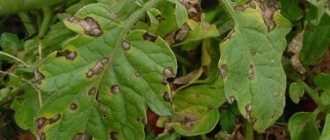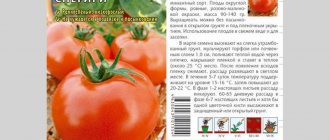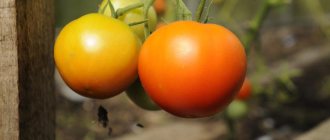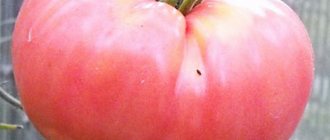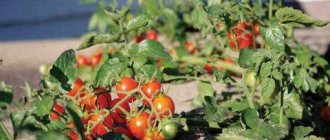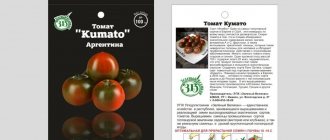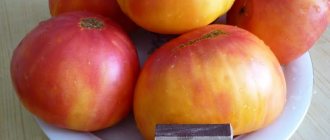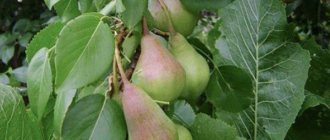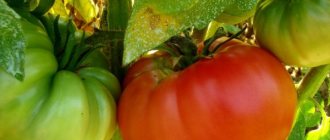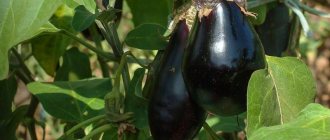Thanks to the continuous work of Russian breeders, the cultivation of tomato crops has become accessible in regions with difficult climates. Residents of the northern regions do not have such a large choice, which is why it is so important for them to create new species that can take root in harsh conditions and bear fruit.
The Pride of Siberia tomato has won universal recognition due to its excellent taste and large fruit size. Simple agricultural technology determined the final choice of many gardeners. Those who have planted tomatoes in their greenhouses completely agree with its name and speak of it with admiration.
Characteristics of the variety
The Pride of Siberia tomato belongs to large-fruited varieties intended for cultivation in protected structures. Nevertheless, the culture takes root well in open beds in regions with a temperate climate.
Distinctive features
The height of the bush is up to 1.5 m. The type is determinant, standard. The stem is powerful, the foliage is moderate. The culture is resistant not only to diseases of various etiologies (late blight, tobacco mosaic virus, brown spot, blossom end rot), but also to temperature changes and lack of sunlight.
The ripening period is early, from the moment of sowing the seeds to full ripening, 85–90 days pass.
The productivity is high: up to 20 kg of fruits are collected from 1 m2, provided that 4-5 plants are planted per 1 m2.
The crop requires mandatory staking and regular pinching due to the heaviness of ripe fruits and the large number of side shoots.
Fruit characteristics
Average weight is 600–700 g, the shape resembles a small pumpkin, the color is rich, raspberry-red. The taste is excellent, sweetness is harmoniously combined with light sourness, the flesh is juicy. The peel is quite durable, so ripe vegetables can be stored for a long time and transported over long distances.
Reference ! Of all the varieties intended for the northern regions, the Pride of Siberia tomato fruits are the largest.
Due to their large size, it will not be possible to pickle and preserve whole vegetables. Otherwise, ripe tomatoes have no equal. They serve as a decoration for any salad, side dish and vegetable dish. In addition, they are processed into excellent juices, pastes, adjika, ketchups, lecho and sauces.
The photo shows Pride of Siberia tomatoes.
Pest and disease control
Tomatoes Pride of Siberia are resistant not only to climatic conditions, but also to diseases, as well as to pests. If you provide proper care, you can guarantee the absence of disease. However, sometimes foliage and fruits are affected by diseases, for example:
- rotting and cracking of tomatoes in contact with the ground;
- whitefly parasitism;
- infection with sooty fungus (may appear after contact with whitefly).
The whitefly causes great damage to the Pride of Siberia tomatoes - if detected, it can be removed mechanically (by picking it up with your hands, rinsing it off with a stream of water)
Therefore, to combat these diseases it is necessary:
- Tie up tomato bushes so that the fruits do not touch the ground.
- Apply a high layer of straw mulch. It will help cope with soil drying out, eliminating the need to frequently water the tomatoes.
- Treat the bushes with a solution of the drug “Confidor” - it copes well with whiteflies. This can be done once at the beginning of the season, and then if necessary.
- In case of aphids or other pests, use folk remedies or insecticides.
Important! As a rule, folk remedies help well in the first stages of treatment. If the pest has spread too widely, it is better to immediately use insecticides.
How to grow seedlings
The gardener can collect the seeds for planting tomatoes himself. Before planting, the seed needs to be prepared.
Seed preparation
It takes place in three stages:
- Rejection of seed material . This is done through a thorough inspection for visible damage.
- Definition of emptiness. Prepare a saline solution (1 teaspoon of salt per 1 cup of water) and place the grains in it for 10 minutes. The seeds that float to the surface are disposed of.
- Disinfection in a weak solution of potassium permanganate: the seeds are kept in the mixture for 20 minutes, then washed with running water and dried. To obtain the desired solution, 1 g of manganese is dissolved in 1/2 tbsp. water.
To improve germination, seed material is germinated on damp gauze for 2-3 days until sprouts appear. The gauze moistened with warm water is left in a dark place at a temperature of +28 °C.
Container and soil
The soil is prepared from garden soil, humus and peat in equal quantities . Washed river sand is added as a leavening agent. For nutritional value, the soil is supplied with a small amount of superphosphate. The resulting mixture is poured with a hot solution of dark manganese. Soil disinfection is necessary for healthy seedling growth. Manganese solution can be replaced with copper sulfate.
Reference ! Copper sulfate destroys fungal spores that are dangerous to tomatoes.
You can plant them in a common wooden box or in separate containers. The main thing is to make drainage holes at the bottom of each container, where excess moisture will drain. In their absence, excess fluid can provoke the occurrence of a dangerous disease - blackleg.
Reference ! Blackleg destroys up to 90% of all plantings. This is a fungal disease characterized by blackening of the stem near the root.
Sowing
To sow seeds, make grooves 1 cm deep. The distance between them is 3 cm. After planting, the soil is slightly compacted and watered with warm, settled water from a spray bottle. The sown containers are left in a bright and warm room at a temperature of +22 °C until germination.
Seedling care
As soon as the first shoots appear, the containers are moved to a more illuminated place on the windowsill. Daylight is necessary for the full development of seedlings. If there is a lack of sunlight, they will stretch out and weaken. Therefore, you should take care of additional lighting in advance, especially in cold regions.
Water the seedlings as the top layer of soil dries out with warm, settled water from a shallow watering can. After moistening, the soil is loosened.
When 2 true leaves appear, the seedlings are picked and planted in separate containers. During picking, the main root is shortened by one third. This promotes the growth of lateral roots, due to which the seedlings develop more intensively.
After picking, the seedlings are fed with a complete complex fertilizer. Fertilizing is combined with watering.
Young plants are hardened 2-3 weeks before transplantation. This procedure is necessary for better adaptation to new conditions. First, the seedlings are taken out into the open air for 1 hour during the day, then the time is gradually increased to 10 hours.
Caring for tomatoes “Pride of Siberia”
After planting bushes of this variety in a greenhouse, you need to continue to monitor their condition and provide the plants with proper care. For active growth and flowering, you need to remove weeds, apply fertilizers and properly water the plants.
Feeding and watering
After transplanting into a greenhouse, young bushes should not be watered for 10–14 days so that the root system adapts to the new conditions. After this period, the tomato bushes are watered frequently and abundantly as the soil dries.
Important! It is necessary to take the necessary preventive measures to prevent some tomato diseases and possible pest attacks. Feeding tomato bushes with fertilizers is an integral part of a good harvest.
Feeding tomato bushes with fertilizers is an integral part of a good harvest.
The following are suitable fertilizers for the Pride of Siberia tomato variety:
- rotted manure;
- bird droppings;
- a solution of water and mullein;
- ready-made mineral fertilizer complexes;
- phosphorus;
- potassium.
After successful adaptation of the seedlings to greenhouse conditions, the tomatoes are fertilized with organic types of fertilizers from the given list. They contain nitrogen necessary for the growth of leaf mass. And at the stage of ovary formation, phosphorus-potassium fertilizers are applied, which contribute to the formation of tasty and large tomatoes.
Stepsoning
Tomatoes of this variety are large in size only if the bush is formed correctly. For best yield, it is recommended to grow the plant with 1 or 2 stems. Excess side shoots and branches must be trimmed. This should be done every week, cutting off excess shoots before they reach a length of 3 cm.
Loosening the soil and weeding
In order for young tomato bushes to grow quickly and gain strength for flowering, you need to weed the soil around them. Weeds growing near tomatoes can block the sun and drink most of the moisture from the soil along with applied fertilizers and nutrients.
Growing bushes of the Pride of Siberia variety need a lot of free space around, and weeds can limit the freedom of growth of tomatoes too much. Therefore, weeds must be removed immediately after their appearance.
Did you know? Tomato roots can penetrate the soil to a depth of 1 m and grow laterally to a distance of up to 2.5 m.
For better air exchange and uniform saturation of the soil with water, the soil around the tomato bushes should be loosened at least once a month. It is best to do this procedure immediately after watering the bushes.
Pest and disease control
The Pride of Siberia variety is resistant to many tomato diseases. But some diseases and pests can still attack the plant and reduce the yield of tomatoes.
List of the most common problems with tomatoes of this variety:
- Cracking tomatoes. It occurs if you water tomato bushes too much. To treat and prevent this problem, you need to water the plants moderately, avoiding too much moisture in the soil.
- Attack by the common whitefly pest. Leads to damage to leaves on tomato bushes and provokes the death of the plant. For treatment, ready-made drugs against this pest are used, for example, “Confidor”. Tomato bushes are irrigated with the prepared solution. For prevention, you need to add fertilizer containing saltpeter to the soil.
- Damage to bushes by wireworms. Most often it occurs when growing tomatoes outdoors, but sometimes the pest is also found in a greenhouse. To prevent the appearance of wireworms, tomato seeds are treated with special disinfectants before planting. You should also not place a greenhouse with tomatoes near potato fields. To distract wireworms from tomato bushes, you can bury wooden sticks with vegetables strung on them in places where pests accumulate. After the wireworms come running for this delicacy, remove the sticks from the ground and burn them.
- Late blight. To prevent disease, the greenhouse should be periodically ventilated and the humidity level should not be too high.
How to grow tomatoes
After the soil warms up to 15 °C, the seedlings are transplanted into the ground. By this time, the bushes have 5–7 true leaves. The soil for planting is prepared in advance: it is dug up and mineral fertilizers are applied.
Landing
No more than 5 seedlings are placed per 1 m2 in a checkerboard pattern. This method of arrangement helps each bush to receive a sufficient amount of sunlight and does not interfere with ventilation.
The holes are made no deeper than 20 cm and filled with warm water. After transplantation, the soil is moistened again and left to adapt for 2 weeks.
Reference ! While getting used to a new place, seedlings are not watered, as they are not able to absorb moisture. All the forces of plants go into adaptation.
Further care for tomato
Regular watering is established as rooting occurs in a permanent place. Moisten the soil abundantly and often, but only with warm, settled water. Seedlings should not be flooded, otherwise increased moisture will provoke the development of fungal diseases. Excess liquid also negatively affects the roots, which can rot.
After watering, the soil is loosened and weeds are removed. Weeds take away many of the nutrients needed for seedlings to grow. In addition, they hide a large number of pests that can cause great damage to tomatoes.
To retain moisture, the beds are mulched with dry leaves, straw or weeds. When the grass rots, it supplies the plant roots with additional nutrition.
Timely application of fertilizing guarantees a high-quality harvest. The crop is fed at least 3 times per season. At the stage of ovary formation, a full complex of minerals with a predominant content of potassium and phosphorus is used as fertilizing. During the flowering and fruiting period, the mineral complex can be replaced with organic matter: for example, aquatic bird droppings or mullein infusion in a ratio of 1:15.
Features of care and possible difficulties
To prevent the fruits from being small, the plant should be formed into 1 or 2 stems. The shaping of the bush also affects the quantitative indicator of fruiting: if the side shoots are not removed in a timely manner, the harvest is significantly less. In addition, an excessive number of stepsons leads to thickening of plants, which negatively affects further development.
The shoots are removed before they reach 5 cm, otherwise the procedure will not be painless for the tomatoes. Plants are planted in the morning so that by evening all the wounds have time to heal. After removing the shoots, the cut sites are treated with a weak solution of potassium permanganate or sprinkled with ash.
Despite the fact that the type is determinate, seedlings without additional support will not withstand the weight of ripe vegetables. During transplantation, wooden pegs or metal rods are installed next to each bush, to which the stem is immediately attached. Fruitful branches are tied to a support as they develop.
Diseases and pests
For tomatoes, the most dangerous attacks are whitefly and spider mites. Spider mites live mainly in greenhouses, since the most favorable conditions for them in terms of temperature and humidity are created there. To eliminate it, it is enough to ventilate closed structures every day. Fresh air destroys the pest’s usual habitat.
Pheromone traps installed near the seedlings help against whiteflies. She is also repelled by plants with strong odors, for example: calendula, onions and garlic. Therefore, they are planted next to tomato beds. When there is a large concentration of parasitic insects, use the insecticide “Confidor”, dissolving 1 ml in 10 liters of water. This drug is also used for preventive purposes.
The crop has strong immunity to nightshade diseases, so preventive measures are quite enough to keep the seedlings healthy throughout the season.
After transplantation, young plants are sprayed with a weak solution of potassium permanganate. Further actions boil down to moderate watering, systematic loosening and weed removal.
To prevent fungal diseases, fungicidal agents such as Fitosporin and copper sulfate are used. Any copper-containing preparations are also suitable for treating plants.
According to the rules of crop rotation, it is not recommended to plant tomatoes next to potatoes. Such proximity leads to negative consequences. These two crops belong to the same nightshade family and are affected by the same diseases and pests.
Agricultural technology
The love for this variety among summer residents is associated with its unpretentiousness. Therefore, even novice gardeners can afford to grow this variety, the main thing is that they have basic skills in caring for cultivated plants.
The soil
Table tomatoes need fertile, oxygen-rich soil. The main parameter is neutral acidity.
The place for permanent landing should be very well lit. The proximity of groundwater is unacceptable.
Growing seedlings
In order not to replant the seedlings several times, it is better to immediately place the seed in any suitable container.
Planting seeds
Features of growing seedlings:
- Seeds are sown in the ground no earlier than the last week of February.
- The first shoots appear 7 days after planting.
- Picking is no different from other varieties. This is done after the first true leaves appear.
- The soil should not dry out. Excessive hydration is not recommended. Abundant watering no more than once a week.
- Feeding with nitrogen, phosphorus and potassium is required. To do this, you can buy any fertilizer suitable for tomatoes.
The time of planting at a permanent place of growth depends on certain circumstances. If this is a greenhouse, then 70 days after planting the seeds, the seedlings are ready for transplanting.
When planting in open ground, you need to monitor the weather. If it is cold, and it is impossible to plant 2 months after the appearance of the first shoots, then the growth of seedlings must be artificially stopped. This is done by lowering the room temperature to 15 degrees. You can also reduce the operating time of the electric paw. After the weather has stabilized, the seedlings are planted in a bed that is pre-fertilized with dolomite flour.
Disembarkation
When planting seedlings, it is worth considering that the variety is tall and bushy. Therefore, there should not be more than 2-3 plants per 1 square meter. The rows are made at a distance of 50-60 cm from each other. 70-80 cm is maintained between the bushes. One seedling is placed in one hole.
Saplings
It is better to immediately stick a reliable trellis or support next to the plant. The soil around the tomato needs to be mulched with straw or hay.
Care
The plant needs pinching in order for it to form one fairly strong trunk. The formation of two trunks is acceptable, but no more. To get a high yield, it is necessary to remove stepsons at least once every 7-10 days. If this is not done, the fruits will be small and the yield will decrease sharply.
Usually the hybrid bush blooms wildly. But you can’t leave all the flowers. There is a rule: there are no more than three flowers in an inflorescence. More than five ovaries should not be left on one hand. It is also necessary to carefully monitor the formation of brushes. As new ones form, it is necessary to thin out the old ones.
Trimming
As the plant develops, the lower leaves need to be removed. So, at the moment of ripening of the fruits on the first cluster, all leaves lower down the trunk should be completely cut off.
The soil around the trunk should always be loosened. Weeds are not allowed to grow and must be destroyed immediately.
Watering
This hybrid loves the sun very much, but does not tolerate watering in the hottest part of the day. Also, do not water the entire plant. Water is directed only to the root. She shouldn't be cold.
Shallots in open ground: growing, planting and care
Watering is carried out in the early morning hours or after six in the evening, no more than 2 times a week. If the weather is not dry, one watering for 7 days is enough.
Watering tomatoes
Top dressing
It all depends on the saturation of the soil with useful microelements. If the soil is well fertilized in autumn and spring, the plants do not need frequent feeding. If the soil is “poor,” then already 2 weeks after planting the seedlings, you can water the hybrid with mineral fertilizer or mullein solution.
Plant growth can be stimulated using nitrogen fertilizer (urea). Usually, once 3-4 weeks after planting the seedlings is enough. Potassium fertilizing will not hurt. It should be carried out 2 times during the entire period:
- At the moment of the appearance of the first flowers.
- When ovaries appear.
The gardener needs to carefully monitor the overall appearance of the plant. If it develops poorly or loses its bright green color, then additional feeding may be needed.
Growing in open ground and greenhouse
In open ground, plant height is significantly lower than that of greenhouse seedlings. Plants look more powerful and compact.
The culture is recommended for cultivation in protected structures, as it was bred specifically for harsh climates. Nevertheless, residents of the southern regions successfully grow the variety in open beds. Moreover, the seeds are planted directly into the ground, bypassing the seedling period.
Annual change of the top layer of soil in greenhouses reduces the risk of various infections. In addition, the new soil is more saturated with useful substances necessary for full development.
When transplanting into open ground, more distance is left between seedlings than in a greenhouse. 2-3 plants are placed per 1 m2 if they are formed into 2 stems. Otherwise, due to the denseness of the plantings, the seedlings will not receive the required amount of light and ventilation. When a bush is formed, 3-4 seedlings are placed in 1 stem per 1 m2.
Characteristics of tomato Pride of Siberia
The pride of Siberia was developed for growing in greenhouses and under film covers - there is no other way to grow tomatoes in the cold northern regions. However, in a mild, warm climate, the Pride of Siberia tomato feels good not only in a greenhouse, but also in open ground.
Productivity and fruiting
This is an early ripening variety of tomatoes - it ripens on average in 90 days. With good care and favorable weather conditions, you can harvest up to 5 kg of tomatoes from one bush.
The good yield of the Pride of Siberia tomato is confirmed by reviews from gardeners; it can also be judged by numerous photos that show how abundantly the bushes bear fruit.
Important! The yield of the variety can be increased by pruning the bushes - they are formed into two stems, cutting off weak shoots.
Area of application of fruits
These tomatoes are usually consumed fresh. In addition, the amount of dry matter in the fruits of this variety reaches 5-7%, so they make good juices, pastes and sauces. The Pride of Siberia tomato is not suitable for preparations - large tomatoes simply will not fit into the jar.
The variety tolerates transportation well, since its fairly thick skin makes them resistant to damage.
Resistance to diseases and pests
Despite the fact that the variety is known for its resistance to various infectious diseases, sometimes it still gets sick. Most often late blight.
When grown in greenhouses, plants may be damaged by the greenhouse whitefly. In open ground, tomatoes often attract wireworms.
Advantages and disadvantages of the variety
Gardeners consider the following characteristics to be the main advantages of the variety:
- large fruit;
- immunity to many diseases;
- high productivity;
- soft taste of fruits;
- good preservation of tomatoes during transportation;
- moderately long-term storage;
- resistance to sudden temperature changes.
Despite the fact that large fruit is present on this list, this quality can also be attributed to the disadvantages of the variety. The accumulation of large fruits on a branch often leads to the bush breaking under the weight of the fruit. For this reason, plants need to be tied or supported.
In addition, Pride of Siberia tomatoes crack in conditions of high humidity, but reducing watering and enriching the beds with saltpeter fertilizers helps to cope with this.
Important! Tomatoes should not touch the ground, otherwise they may rot.
Harvesting and application
Tomatoes are not allowed to overripe by harvesting on time. Ripe vegetables can be stored for a long time in a cool, dry place. Thanks to their durable skin and dense pulp, tomatoes do not deform or crack during long-term transportation.
The excellent taste allows vegetables to be used universally in cooking. They make excellent summer salads, first and vegetable courses, various snacks and cuts. The obvious sourness does not disappear when preparing freshly squeezed and canned juices, which adds a piquant taste to tomato products. Among winter preparations, vegetables are suitable for marinades, pickles, ketchups, adjika, lecho, sauces and pastes.
Characteristics of the Siberian early ripening tomato
Some gardeners point out in their reviews the shortcomings of the fruits of the Siberian early ripening tomato. But the variety has advantages and quality indicators. In the process of breeding it, domestic breeders tried to take into account all the problematic issues associated with growing tomatoes in open ground in Siberian conditions.
Productivity of Siberian early ripening tomato
Fruiting of tomato crops differs depending on the growing environment. When grown in closed soils, an average of 1–1.5 kg is harvested from one bush, and the total yield is 9–10 kg/sq.m. m. In open ground conditions from 1 sq. m you can get 6–7 kg of ripe tomatoes, from a bush approximately 500–600 g.
It is not surprising that the yield in greenhouses is higher, but the taste of the Siberian early ripening tomato, which grew without shelter, received more positive reviews.
Advice! To extend the shelf life and not lose the taste of the fruits, they should be placed tightly in rows in a box and the lid should be tightly closed. So that the tomato stalks are on top.
A prerequisite is that the tomatoes must be dry. In such conditions, vegetables can be stored for up to 60 days.
Area of application of fruits
Despite positive reviews from gardeners, tomatoes of the Siberian early ripening variety do not have pronounced taste characteristics. Universal characteristics are similar to other varieties. Due to the high content of dry substances, tomatoes are used to prepare sauces, pastes, ketchups, juices, and purees. Suitable for pickling and fresh consumption.
Resistance to diseases and pests
The Siberian early ripening tomato is immune to various fungal and viral diseases. High resistance should be noted to tobacco mosaic and brown spot. But when growing, there is a risk of encountering the following ailments:
- gray mold, which is treated with triazole drugs and systemic fungicides;
- late blight - you can get rid of it using copper-containing components, 10% saline solution;
- Fusarium and Alternaria - only systemic fungicides will help cure a vegetable from them.
Trouble is also caused by harmful insects: nematodes, mole crickets, aphids, and wireworms. Folk remedies will help in the fight against parasites, and if they become widespread, insecticides will help.
Attention! Compliance with the rules for caring for the Siberian early ripening tomato variety reduces the risk of diseases.
Advantages and disadvantages of the variety
Based on the description of the variety and practical conclusions, we can draw up a number of advantages of the Siberian early ripening tomato:
- early ripening variety;
- universal use of fruits;
- considerable productivity;
- withstands cold weather and develops under these conditions;
- immunity to fungal and viral diseases;
- unpretentiousness to the growing environment;
- simultaneous ripening of fruits;
- good transportability;
- possibility of long-term storage.
The disadvantages of this variety include:
- need for tying;
- inability to compete with modern varieties;
- short shelf life of fruits.
Advantages and disadvantages
Culture has a number of positive qualities, thanks to which it has received universal recognition:
- ability to adapt to harsh climates;
- early ripening;
- unpretentious care;
- resistance to dangerous diseases;
- high yield;
- excellent taste;
- large-fruited species;
- long-term storage;
- universal use;
- safety of fruits during long-term transportation.
The disadvantages include the obligatory garter, the formation of a bush and the regular removal of stepsons.
Growing rules
Even a beginner can grow tomatoes of this variety, as it is quite easy to care for. In greenhouse conditions, it can be grown throughout the country, but planting in open ground is possible only in the southern and central regions of the European part of Russia.
Planting seedlings
The step-by-step preparation of seedlings can be described as follows:
- Disinfect the seeds in a weak solution of manganese.
- In March, the seeds are sown in loose, heated soil, previously fertilized. To prevent fungal diseases, it is recommended to disinfect the soil again, this time. To do this, it is sprayed with a solution of copper sulfate.
- The distance between two adjacent seeds is 2-3 cm. They are sprinkled with earth and sprayed with water at room temperature.
- The container with the seeds is covered with film and placed in a dark room. Optimal room temperature: +25°C.
- With the appearance of the first leaves, the seedlings are placed on the windowsill and the protective film is removed.
- When at least 2 true leaves appear on each seedling, they are distributed into separate containers. This procedure is called picking, which allows the tomatoes to harden the root system.
- If there are 5-6 leaves, the tomatoes are moved to the beds.
This video provides additional information on preparing seeds for seedlings:
https://youtube.com/watch?v=PbLZkYCt2iE
Tomato transplant
When moving seedlings to open ground or a greenhouse, it is recommended to follow a planting scheme in which the distance between neighboring bushes is at least 1 m. This is a very large-fruited variety, so thickening the beds can cause inhibition of the growth of tomatoes - they simply will not have enough light and nutrients. Thus, for 1 sq. m there are at most 3 bushes. If you form tomatoes not into 2 stems, but into 1, then you can increase the planting density to 4 pieces. per 1 sq. m.
Subsequent care for tomatoes
The variety is unpretentious, but responds well to watering and fertilizing. However, the bushes are not watered for the first two weeks, since young seedlings at this time are not able to fully absorb moisture. After this time, the tomatoes are watered frequently and abundantly. When watering, be sure to use warm, settled water - cold water can cause root rot.
It is better to water in the morning to minimize the risk of sunburn of the foliage.
The bushes are fed with phosphorus, potassium, as well as organic matter: bird droppings, manure, mullein. Potassium and phosphorus fertilizers are usually applied during the period of active plant growth.
Bush pruning is also required. The abundance of shoots will cause the fruits to become small and watery, so they are pinched, leaving 1-2. Finally, due to their large fruits, the bushes are tied up, otherwise the branches with tomatoes may break.
Farmer reviews
Favorable reviews of the Pride of Siberia tomato are another big plus. Many gardeners choose varieties for planting based on the characteristics of the crop and reviews from experienced gardeners.
Kristina, Novosibirsk: “The tomato is excellent for growing in the difficult Siberian climate. The fruits are really large, juicy and very tasty. The seedlings do not get sick and are not damaged by pests. I like this species for its sustainability, taste and easy care. I’ve been planting for several years now and I’m happy with everything.”
Anatoly, Krasnodar region: “The weather here is excellent, I sow the seeds directly into the garden bed. Everyone comes up. The seedlings are strong, up to 110 cm high. I form them into 1 and 2 stems. The yield is excellent, 4.5 kg from each bush. This is a good indicator, so I’ve been growing it for three years now and will plant it again.”
Tomato “Pride of Siberia”: description of the variety
| Variety name | Pride of Siberia |
| general description | Early ripening determinate variety |
| Originator | Russia |
| Ripening period | 85-100 days |
| Form | Round, slightly flattened |
| Color | Red |
| Average weight of tomatoes | 750-850 grams |
| Application | Universal |
| Productivity of the variety | 23-25 kg per sq.m. |
| Features of cultivation | Standard agricultural technology |
| Disease resistance | Prevention of certain diseases is required |
The “Pride of Siberia” tomato was obtained by domestic selection masters and received state registration as a variety in 2006. Since then, it has been popular among those who prefer large-fruited tomatoes.
According to the type of bush, it belongs to determinant, standard plant species. It can be grown in open ground, but is more suitable for greenhouses. This species is characterized by high immunity to the main diseases characteristic of tomatoes in greenhouses. “Pride of Siberia” is an early-ripening variety of tomatoes, that is, from the moment of planting the seedlings to the first fruits, 85-100 days pass.
After the fruits have reached varietal maturity, they are red in color, round in shape, slightly flattened. Ripe tomatoes are quite large, can reach 950 grams, but usually 750-850, the number of chambers is 6-7, the dry matter content is up to 6%. The harvested crop is well stored.
You can compare the weight of the fruits of this variety with others in the table below:
| Variety name | Fruit weight |
| Pride of Siberia | 750-850 grams |
| Explosion | 120-260 grams |
| Crystal | 30-140 grams |
| Valentina | 80-90 grams |
| Baron | 150-200 grams |
| Apples in the snow | 50-70 grams |
| Tanya | 150-170 grams |
| f1 favorite | 115-140 grams |
| Lalyafa | 130-160 grams |
| Nikola | 80-200 grams |
| Honey-sugar | 400 grams |
With proper care of tomato bushes of this type, you can get up to 4-5 kilograms per bush, and with the recommended planting, 4-5 bushes per square meter. meter turns out to be 23-25 kilograms per square meter. meters, which is quite good.
| Variety name | Productivity |
| Pride of Siberia | 23-25 kg per square meter |
| Boni M | 14-16 kg per square meter |
| Aurora f1 | 13-16 kg per square meter |
| Leopold | 3-4 kg per bush |
| Sanka | 15 kg per square meter |
| Argonaut f1 | 4.5 kg per bush |
| Kibitz | 3.5 kg per bush |
| Heavyweight of Siberia | 11-12 kg per square meter |
| Honey cream | 4 kg per square meter |
| Ob domes | 4-6 kg per bush |
| Marina Grove | 15-17 kg per square meter |
Among the main advantages of this variety, gardeners note:
- high productivity;
- good taste of ripe fruits;
- disease resistance;
- large and beautiful fruits.
Among the disadvantages of the variety, it is noted that the branches of the bush are weak and require garters or supports to avoid breaking off the branches.
Due to their excellent taste, these tomatoes are perfect for fresh consumption. They also make a good juice or paste. They are most likely not suitable for homemade preparations due to their large fruit size. Among the main features of this type of tomato are its early ripening and large-fruited nature.
Another important quality for those who grow tomatoes for sale is productivity and high commercial quality
What is mulching and how to do it? Which tomatoes require pinching and how to do it?
>Photo
Next you will see photos of the tomato variety “Pride of Siberia”:
Preparing and planting seeds
Prepare the seeds for planting by pre-treating them with a solution of potassium permanganate or hot water. After this, germinate the seeds under a damp cloth in a warm place. Greenhouse tomato seedlings begin to be grown at the end of March.
It is at this time that the seeds must be sown in the soil. Place them on the ground at a distance of a couple of centimeters and sprinkle with dry substrate. Next, water the soil with warm water. Cover the container with film and put it in a warm place (24–26 °C) and protected from the sun.
When the first shoots appear, remove the cover. Raise the seedlings on the table, providing them with light, moisture and warmth (20–24 °C). When the tomatoes grow two true leaves, plant the bushes in individual containers. When transplanting, do not forget to prick the seedlings: this way the root system will prepare for the upcoming transplant into the greenhouse, and the bushes themselves will harden and become stronger.
Stretched plants need to be fertilized. To do this, it is better to use special complex fertilizers consisting of microelements required for tomato seedlings.
When the seedlings are 40–45 days old, begin to harden them. Move the pots first closer to the open windows, then to the balcony or outside. The hardening time should be gradually increased - the tomatoes must quickly adapt to the climate of the greenhouse.
Important! Before planting seedlings, the greenhouse must be prepared in advance: replace the top layer of soil, wash the walls and all structures with a disinfectant. Ventilation is an important final stage in preparing a greenhouse.
At the stage of 6–7 true leaves, you can transplant the seedlings to a permanent place. It is advisable to plant bushes in rows. Considering the large-fruited nature of the Siberian variety, you should not place more than five seedling bushes on one square meter of bed. The holes should be quite deep so that the rhizome can fit freely there.
Carefully remove the plant from the pot, supporting the root with the soil with your hands. Lower the seedlings into the hole until they reach the first set of leaves. Now you can fill it with substrate and press down the soil with your hand. Make a small hole around each bush for watering. Immediately at the stage of planting seedlings, insert a peg near each bush, to which the trunk will be tied as it grows.
